Tucked just beyond the rolling hills of northern Lazio, less than two hours from Rome, San Pellegrino is the medieval heart of Viterbo, a city often described as one of the best preserved medieval towns in Europe. The atmospheric district resembles a set from a period drama, a labyrinth of cobbled alleys, perfect stone archways, austere towers, and vine-clad loggias that practically scream "Middle Ages".
For travellers searching for hidden gems in Italy, Viterbo’s San Pellegrino is a top alternative to the crowded streets of the capital. Here is what to know.

San Pellegrino Viterbo is the largest medieval district in Europe
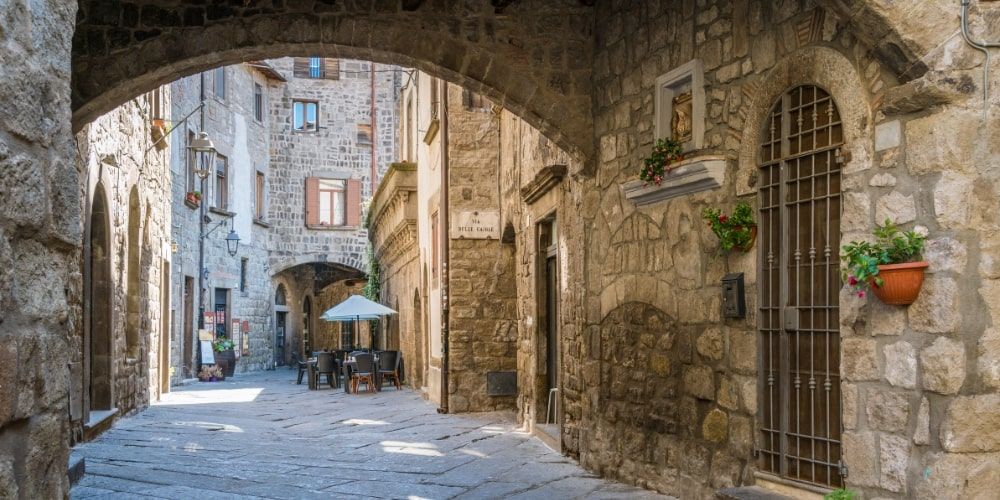
For lovers of medieval architecture in Italy, San Pellegrino is a textbook in stone. Imposing towers, arched loggias, sturdy houses clustered around hidden courtyards: it has everything one imagines when picturing a 13th-century town.
That of Viterbo is the largest medieval quarter in Europe, and arguably the best conserved. Unlike other Italian towns where architecture from the Middle Ages coexists with heavy Renaissance and Baroque additions, this one has kept its original character. Stone palaces, narrow streets, communal squares, and profferli (the local external staircases) remain much as they were centuries ago.
It stretches from Piazza San Carluccio to Piazza San Pellegrino, winding through side alleys and hidden corners. Yet, despite its atmosphere, it is a lively quarter where people still live, work, and socialize every day.
DIscover ViterboSan Pellegrino in Viterbo: where everything feels like the movies
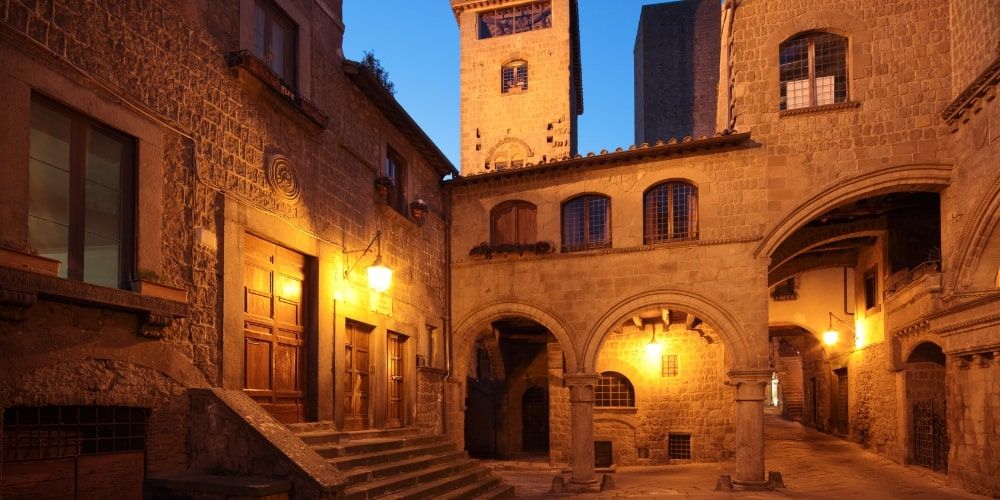
Daily life unfolds in a setting that bridges past and present or, as epic fantasy fans would suggest, a faraway land like Westeros or Middle-earth.
It’s true that Viterbo’s San Pellegrino feels like a film set. Indeed, film crews have long been drawn to its evocative backdrops, with major productions like Dario Argento’s The Stendhal Syndrome, Netflix’s The Decameron, and Julian Schnabel’s forthcoming In the Hand of Dante making use of its cinematic charm.
The list of films and series shot in Viterbo also features Fellini’s classic I Vitelloni, Pasolini’s Decameron, and Paolo Sorrentino’s The Young Pope.
So, if some of the streets and city views feel familiar, chances are they really are.
Things to do in Viterbo’s San Pellegrino
As soon as you enter San Pellegrino from Piazza San Carluccio, Viterbo’s medieval district wastes no time in showing off its soul. Needless to say, it feels as if you’ve stepped straight out of the DeLorean DMC-12 of Back to the Future.
Winding alleys, old towers, narrow arches, stone pavements, and grey tones of peperino and basalt make it clear what era shaped this place.
Here and there, external staircases climb the buildings like stone ivy. They’re called profferli, a quaint reminder of the days when life downstairs was for trade and upstairs was for family.
Look for suspended houses that bridge one side of an alley to another: they are some of the prettiest corners to see.
A perfect Middle Age allure defines Piazza San Pellegrino. It’s the heart of the quarter and boasts some of the finest medieval architecture Italy has to offer. The place is lined with a few of Viterbo’s highlights: the 13th-century Palazzo degli Alessandri with its graceful arches; Torre Scacciaricci, among the oldest monuments in town; and the museum that celebrates the UNESCO-honored Macchina di Santa Rosa tradition, an unmissable event in Italy.
From these timeless streets, you’ll see what Viterbo looked like when it earned its place in papal history.
The Papal city of Viterbo and the longest Conclave in history
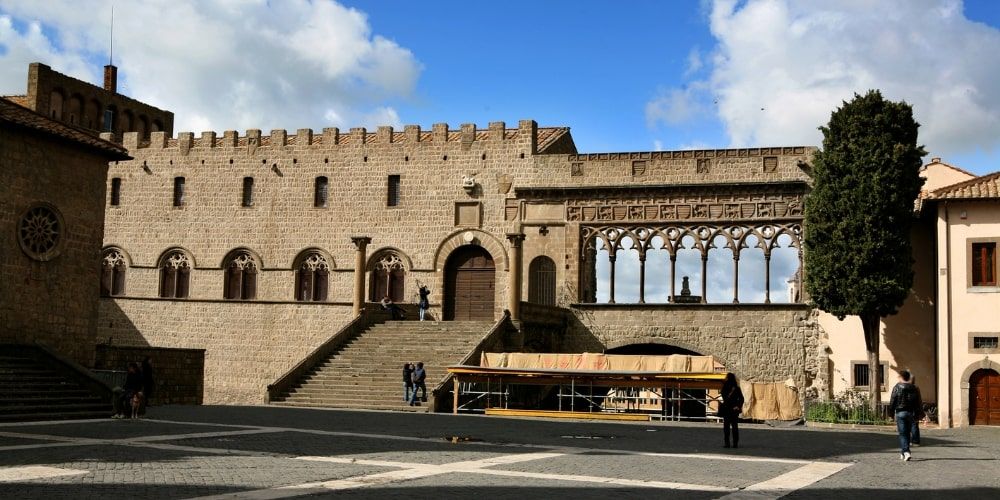
Of all the Italian towns near Rome, Viterbo holds a singular place in Church history. Between 1257 and 1281, it served as the seat of the papacy, chosen for its distance from the turmoil and political strife of Rome.
It was in Viterbo that the longest conclave in history took place, one that would ultimately change the rules of papal elections.
It went on from 1268 to 1271. Cardinals debated for nearly three years over who would succeed Pope Clement IV. At one point, they were literally locked inside the papal palace (hence the word “conclave”, meaning “with key”) to spur them into making a decision. When it became clear that even confinement was not enough, the roof of the building was removed in the hope of finally forcing a name to emerge!
From that experience came the model of papal election still in use today, with the cardinals isolated until the new pope is proclaimed.
- Where to go: Palazzo dei Papi in Piazza San Lorenzo is part of the Polo Monumentale Colle del Duomo , which also includes the Church of San Lorenzo and the Colle del Duomo Museum. It houses the Aula del Conclave, the very hall where the longest conclave in history took place. The monumental complex is among the best things to see in Viterbo.
Events and traditions in San Pellegrino, Viterbo
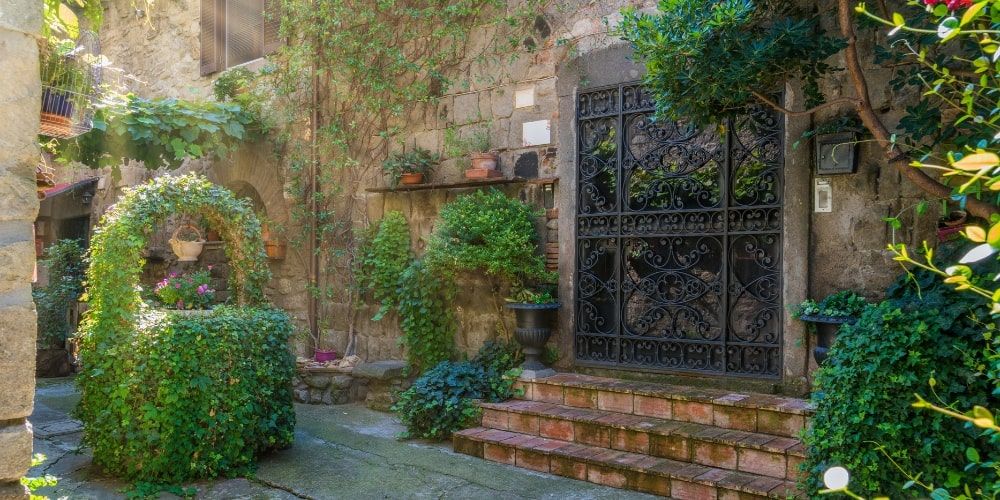
Far from being a static relic, San Pellegrino hosts a number of festivals and traditions, and for travellers seeking hidden gems in Italy, these celebrations are among the most memorable things to do in Viterbo.
Between late April and early May, the flower festival San Pellegrino in Fiore makes a vast open-air garden out of the largest medieval quarter in Europe. Many compositions are interactive, so visitors can wander through the displays and snap photos. The schedule also includes parades with flag-throwers, costumed performers, art shows, gardening workshops, and plant markets. Urrà!
Summer brings San Pellegrino in Festa: Piazza San Carluccio and the nearby lanes fill up with street art, markets, and activities for all ages.
At Palazzo degli Alessandri, La Notte dei Templari (weekends, August–September) recreates the world of the Knights Templar with exhibitions, archery, swordplay, and re-enactments along torch-lit streets.
In July, Ludika 1234 takes over Viterbo’s historic center with a summer festival of medieval games, colourful parades, and lively performances evoking the 13th-century atmosphere.
Finally, festive lights brighten Viterbo’s medieval streets in December with the Christmas Village. Santa’s House opens inside Palazzo degli Alessandri, complete with sleighs, reindeer, and plenty of letters from children.
Practical tips for visiting San Pellegrino Viterbo
- Getting there: Regional trains from Rome take about two hours. Trains stop at Porta Fiorentina and Porta Romana; Porta Romana is the best stop if you want to head straight to the medieval quarter of San Pellegrino.
- Where to park: You’ll find both paid and free parking along Via delle Fortezze, near Porta San Pietro. Piazza della Rocca, near Porta Fiorentina, offers paid parking only. Valle Faul, right inside Porta Faul, is entirely free and has an elevator that brings you up to Piazza del Palazzo dei Papi. For a larger paid lot, head to the Sacrario area (Piazza Martiri d’Ungheria) inside the city walls.
- Where to stay: B&Bs and diffusi hotels are set in beautifully restored medieval buildings in the heart of the quarter.
- Where to eat: San Pellegrino has cosy trattorias, pubs, and restaurants serving traditional Viterbese dishes, as well as lively bars and gelato shops tucked into its medieval corners.
- What to eat: Try local specialities such as lombrichelli pasta, rabbit stews, and gnocchi co’ i ferro, which are handmade gnocchi shaped with a knitting needle. Acquacotta is a rustic soup with wild greens and vegetables. Tozzetti are crunchy biscuits filled with local hazelnuts.
- Best time to visit: In spring, during San Pellegrino in Fiore (April–May); in summer, the first week of September for the Macchina di Santa Rosa festival; from late November to January for the Christmas markets.
The district of San Pellegrino: authentic Italy beyond the beaten track
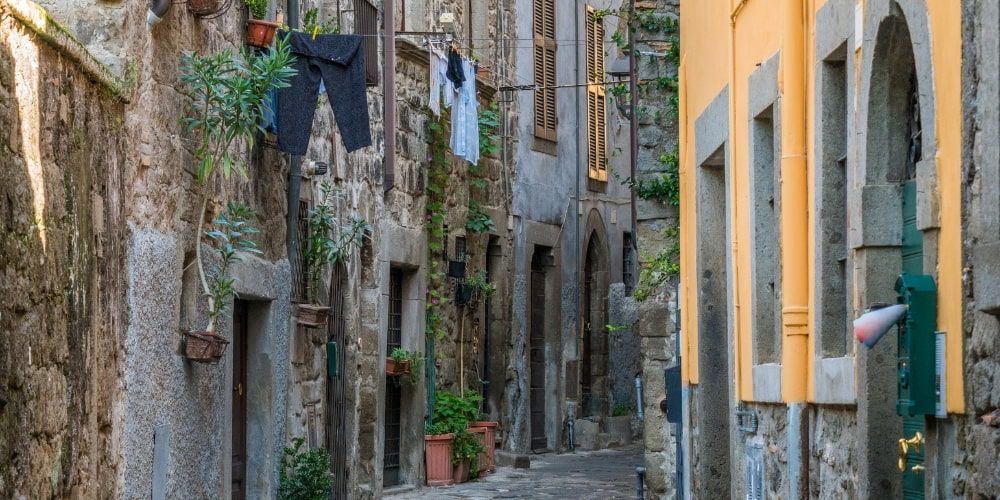
If you’re looking to see more than Rome’s usual sights when travelling in central Italy, head to San Pellegrino in Viterbo. The district, reminiscent of Viterbo’s years as a papal city, is a window into Italy’s medieval architecture and remains almost untouched by modernity.
Nevertheless, it’s a lively spot to enjoy your time sightseeing, trying local specialities, and spending the night in old-world-style stays. You’ll love the local festivals and the kind of hospitality that makes you feel at home.
Viterbo is one of Visit Italy’s top Italian destinations for 2025.
San Pellegrino, Viterbo's medieval quarter – FAQs
Is San Pellegrino really the largest medieval quarter in Europe?
Thanks to its extension and intact period streets and buildings, San Pellegrino in Viterbo stands out as one of the largest, most complete, and finest surviving medieval quarters in Europe.
What can visitors see and do in San Pellegrino?
Take a stroll through the neighbourhood to get a feel for daily life and admire typical architectural details, such as profferli and case-ponte (the covered bridges that link two palazzi). Stop by the 11th-century Church of San Pellegrino, Palazzo degli Alessandri, and Museo di Santa Rosa. The Papal Palace, located in Piazza San Lorenzo, is a short walk away.
How far is Viterbo from Rome, and how do you get there?
Viterbo is about 80 kilometers north of Rome. You can get there by train in around 2 hours or by car in about an hour and a half. Porta Romana station is the handiest stop for the San Pellegrino medieval quarter.
Are there medieval festivals in Viterbo’s San Pellegrino quarter?
San Pellegrino Viterbo hosts the medieval festival Ludika 1234 in summer, featuring role-playing games, parades, historical reenactments, sword tournaments, and banquets.
About the author
Written on 10/10/2025


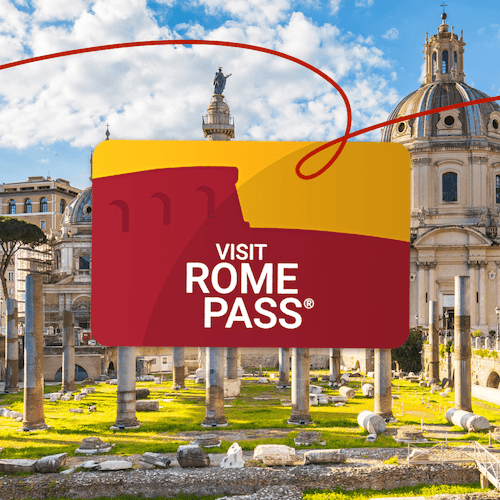
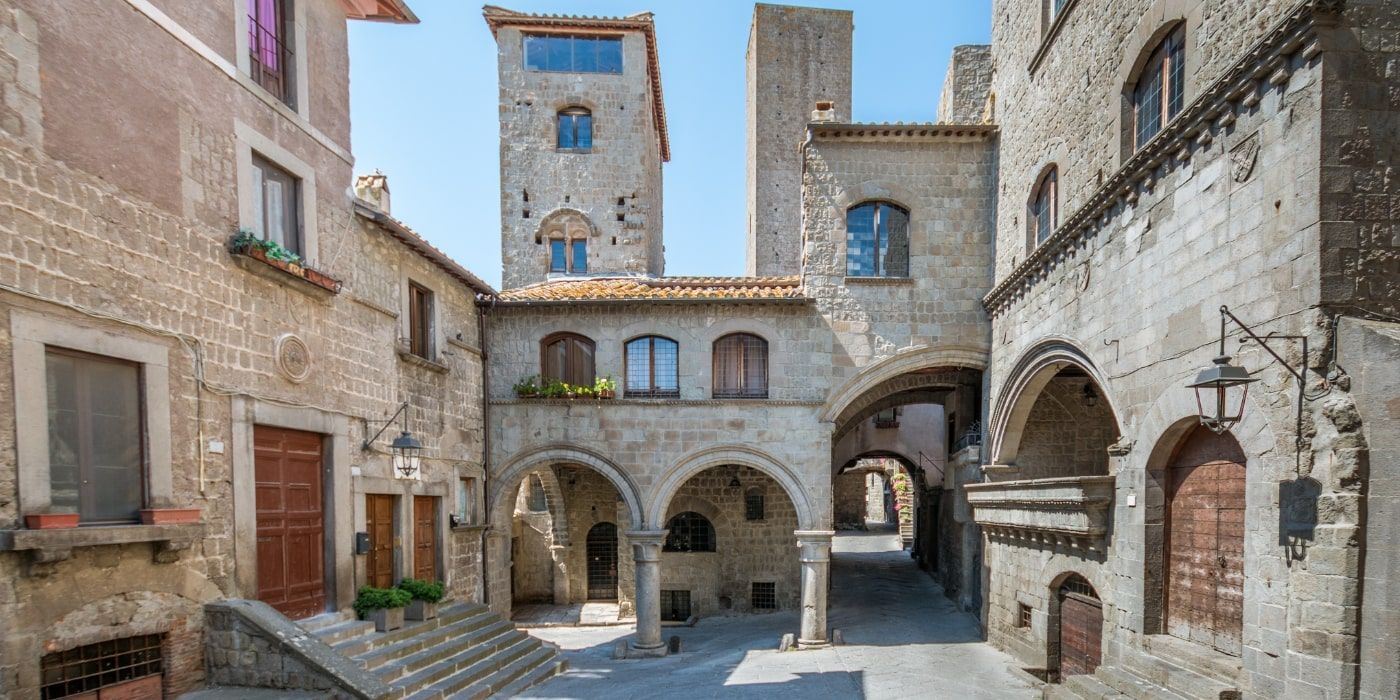

Lorena Calise
Viterbo is home to a vast, impeccably preserved medieval quarter. Here’s everything you need to know to visit San Pellegrino.